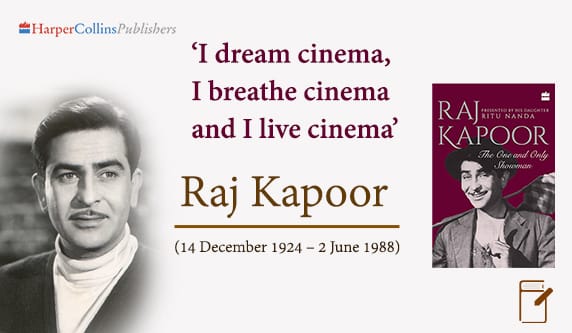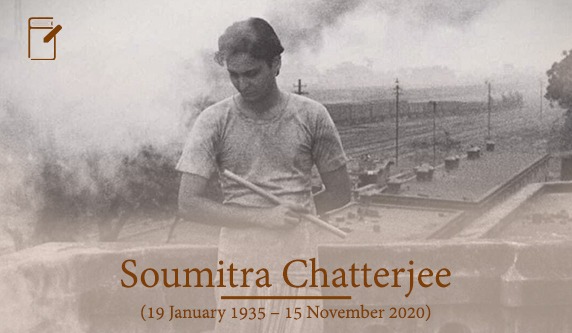Defining and living the term: Showman, Raj Kapoor not just carved out a niche for himself but cemented it into a legacy.
Who was Raj Kapoor? An actor? A filmmaker? A studio head? A producer? Or, simply a man who believed in his dreams. Clearly, the world needed the word, Showman, a word that glitters even in this black digital ink.
Prithviraj Kapoor was a massive banyan tree around whom several saplings naturally grew but there was one Awaara Groot who could not sit idle. The limpid-eyed, coy-looking young man could never match the sturdy look of his father.
Duniya usi ki hai jo chalta jaye…
Although Raj Kapoor debuted as a child artist in Inquilab (1935), he had other ideas. In 1948, at the age of 24, he established his own studio, R. K. Films. The young Raj Kapoor then embraced various aspects of filmmaking by directing his first film, Aag.
However, his first major success came from Mehboob Khan’s classic, Andaaz (1949), co-starring Dilip Kumar and Nargis. He had his first success as a producer-director, and a star in Barsaat released later that year.
Thus began the greatest show of Hindi Cinema.
Raj Kapoor, Shree 420 at Work!
Subsequently, Raj Kapoor produced and starred in several hit films made under his own banner, R. K. Films including Awaara (1951), Shree 420 (1955), Jagte Raho (1956), and Jis Desh Men Ganga Behti Hai (1960). This phase of his cinematic life established his screen image modelled on Charlie Chaplin‘s most famous screen persona of ‘The Tramp’.
The Anari, the ultimate rookie, had turned pro.
With films such as Dastan (1950), Anhonee (1952), Aah (1953), Chori Chori (1956), Anari (1959), Do Ustad (1959), Chhalia (1960), and Dil Hi To Hai (1963), he further marked his territory which, needless to say, was massive.
Raj Kapoor, the One and Only Showman
Throughout his life, Raj Kapoor maintained his notes in varied forms. Just like his magnum opus, Mera Naam Joker (1970), his body of writings was immense and exemplary.
In 2017, HarperCollins published an updated version of his biography written in his voice by his daughter, Ritu Nanda.
The book was first published in the late 1980s.
In its preface, Ritu Nanda explains how intimidated she felt at the prospect of writing her father’s biography. She prayed to the saint Sai Baba for guidance: In the holy book Sai Satchitra, the author addresses Baba in the very first chapter: “How can I write a book about you? You are God and I am a mere human being!” Sai Baba appears to him and says, ‘You write and I will write through you.’
The following excerpt from Raj Kapoor’s earlier days of filmmaking provides interesting insights into a socially conscious creative mind:
I will never forget Aag, because it is a story of youth consumed by the desire for a brighter, more intense life. It is about all those who flitted like shadows through my own life, giving something, taking something… There was never enough money, it was an uphill struggle from the mahurat of the picture to the day of its release. I mortgaged my car. I even borrowed money from my old servant Dwarka to buy tea and food for my unit. I remember my mother telling my father, using a sarcastic Punjabi phrase, that you can’t fry pakoras in spit, meaning that I would never be able to make the film without any resources. My father just turned around to her and said, ‘You wait and watch. The boy will make the film. He has the confidence and the conviction.’ I couldn’t forget those words, and still haven’t, because that’s really all you needed in this business.
While making Aag there were even times when I carried tins of my film from one distributor’s office to another, hoping to get buyers for it and finding none – till one day when I arranged for a small group of distributors to see the rushes of the half-completed film. The verdict was: ‘This film will not run in any territory.’ One distributor had even gone to sleep, he was so bored! But this man never liked seeing rushes away. He said to me: ‘I don’t back a picture, I back a man. Whether this film runs or not, I must have it at all cost.’ He shook the hand of an anxious and ambitious film-maker, vigorously, pressing a single silver one rupee coin in his palm, and the deal was struck. From that day onwards, every picture I have made has gone as a matter of course to this distributor of mine who, long before anyone else, had the courage and the vision to back an unknown youngster embarking on the perilous seas of a film career. What convinces me about a script is that there is enough human value in the story. Aag had just such a script. It drew upon the experiences of my father (Prithviraj Kapoor’s father wanted him to study law but Prithviraj wanted to become an actor). The film is about a young man who wants to be a stage actor, disappointing parents who had hoped for a lawyer. It stirred up a lot of people. It ran for sixteen weeks in those days. It was a totally different film, which came with a bang.
The Show Must Go On!
Raj Kapoor put his entire faith in Mera Naam Joker (1970). However, its reception was so shockingly abysmal that almost the entire film industry went into a meltdown. Some observed that he got swept away by a blizzard of the name of Rajesh Khanna, while others believed that the proximity to the project blinded him so astonishingly that the film felt strangely distant and disrespectful to the evolving sensibilities of the audience.
Resultantly, Raj Kapoor’s filmmaking career came to a sudden halt. Although he made a roaring comeback by launching his son Rishi Kapoor with Dimple Kapadia in Bobby (1973), he was never the same person again.
Nonetheless, Mera Naam Joker (1970), like Raj Kapoor, stood the test of time and is now considered a classic. Even though it still receives different opinions lekin…
…Samajhne wale samajh gaye hain, na samjhe!?… Na Samjhe wo anari hain!





No Comments